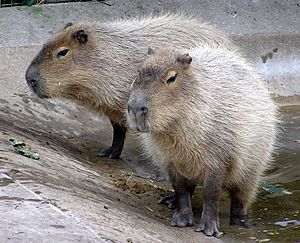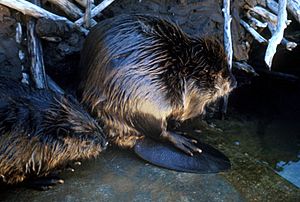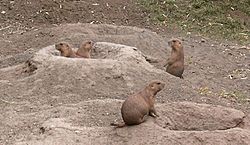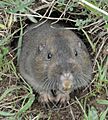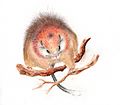Rodent facts for kids
Quick facts for kids RodentsTemporal range: early Paleocene – Recent
61.7 mya to present |
|
|---|---|
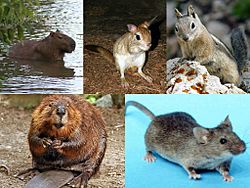 |
|
| a squirrel | |
| Scientific classification | |
| Kingdom: | |
| Phylum: | |
| Class: | |
| Infraclass: | |
| Superorder: | |
| Order: |
Rodentia
Bowdich, 1821
|
| Suborders | |
|
Sciuromorpha |
|
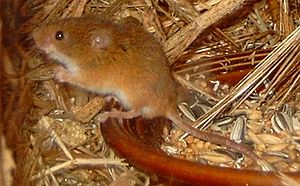
Rodents are a very successful group of mammals. They belong to the animal group called the order Rodentia.
Rodents have four special incisor teeth at the front of their mouths. These teeth never stop growing! To keep them from getting too long, rodents must constantly gnaw or chew on hard things. This is how they got their name. The word "rodent" comes from the Latin words rodere, meaning "to gnaw," and dent, meaning "tooth."
Most rodents are small. You probably know common rodents like mice, rats, chipmunks, and squirrels. Some small rodents that people keep as pets include Guinea pigs, hamsters, and gerbils. There are also larger rodents. Examples are porcupines and beavers. The biggest living rodent is the capybara. It can grow to be 105 to 135 cm (about 40-55 in) long and weigh 35 to 65 kg (about 75-140 lbs).
Almost half of all species of mammals are rodents! Other examples of rodents are voles, prairie dogs, groundhogs, and chinchillas.
Sometimes, people think Rabbits, hares, and pikas are rodents because their teeth also keep growing. But in 1912, biologists decided to put them in their own separate group called Lagomorpha. This is because they have two extra incisor teeth in their upper jaw. Shrews might look like mice, but they are not rodents either. They belong to a different group called Insectivora.
Contents
What Makes Rodents Special?

Rodents are usually small animals. Most species weigh less than 100 grams (about 3.5 ounces). The largest rodent, the capybara, can weigh up to 66 kg (about 145 lbs). Rodents often have sturdy bodies and short legs. Their front paws usually have five fingers, sometimes with a very small thumb. Their back feet can have three to five toes. Their elbows allow their front arms to move very flexibly. Most rodents walk on the palms of their hands and soles of their feet, and they have claw-like nails.
While most rodents are not built for fast running, some, like the agouti, are very quick. Kangaroo mice and jerboas can hop as fast as 48 kph (30 mph)! Water-loving rodents like beavers have webbed feet. Squirrels are very good at using their front paws. Most rodents have tails, which come in many shapes and sizes. Some tails, like those of the Eurasian harvest mouse, can even grip things. Tail fur can be bushy or completely bald. Some rodents have tiny tails or no tails at all. In some species, a broken tail can even grow back!
Rodents generally have excellent senses of smell, hearing, and sight. Rodents that are active at night often have large eyes. Many species have long, sensitive whiskers that help them feel their way around. Some rodents have cheek pouches inside their mouths. They can store food in these pouches and even turn them inside out to clean them! Rodents have very good digestive systems. They can absorb almost 80% of the energy from the food they eat. Some rodents even eat their own waste to get all the nutrients from their food.
Where Do Rodents Live?
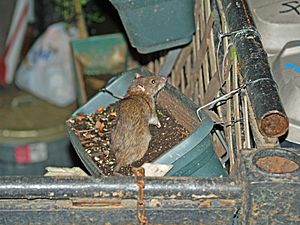
Rodents are one of the most common groups of mammals. You can find them on every continent except Antarctica. Along with bats, they are the only placental mammals that reached Australia and New Guinea without human help. Humans have also helped them spread to many islands. Rodents have adapted to almost every type of land habitat. They live in cold tundra (where they hide under the snow) and hot deserts. Some species live in trees, while others build complex burrows underground. Beavers and muskrats are known for living in and near water. Rodents also do very well in places created by humans, like farms and cities.
Even though some rodents can be pests for humans, they are very important in nature. Rodents that burrow can eat fungi and spread their spores through their waste. This helps fungi form special partnerships with plant roots, which are often needed for healthy forests. Some rodents are even called "keystone species" or "ecosystem engineers." This means they play a huge role in their habitats. For example, in the Great Plains of North America, prairie dogs dig tunnels that help the soil get air and move nutrients around. They also help keep grasslands healthy. Beavers build dams that change streams and rivers, creating large wetland areas. This can increase the number of plant species and even help wild salmon populations.
How Rodents Behave
Social Life of Rodents
Rodents have many different ways of living together. Some, like certain mole rats, have a social system similar to ants or bees, with a "queen" and "workers." Others, like the prairie dog, live in huge "towns." Some live in family groups, while others, like the edible dormouse, live alone.
For example, male and female dormice live by themselves. They only meet briefly to mate during the breeding season. Their feeding areas might overlap, but they live in separate nests and find food alone. The female raises her young without any help from the male. The pocket gopher also lives alone outside of the breeding season. Each one digs a complex tunnel system and protects its own area.
Larger rodents often live in family groups. Parents and their young stay together until the young are old enough to leave. Beavers live in extended family units. These usually include a pair of adult beavers, their babies from this year, their young from the previous year, and sometimes older offspring.
Brown rats usually live in small groups. Up to six females might share a burrow, and one male will protect the area around it. If there are too many rats, this system can change. Males might form a pecking order, and their territories might overlap. Female young usually stay with the group, while male young move away.
The prairie vole is a monogamous animal, meaning it mates with only one partner for life. Outside of the breeding season, prairie voles live close to others in small groups. A male is not aggressive towards other males until he has mated. After mating, he protects his territory, his female partner, and their nest from other males. The pair stays close, grooms each other, and shares the duties of nesting and raising their babies.
Among the most social rodents are the ground squirrels. They usually form colonies based on female family ties. Males leave the group after they are weaned and become wanderers as adults. Ground squirrels help each other in different ways, depending on the species. This can include making alarm calls, defending their areas, sharing food, and protecting nesting spots. The black-tailed prairie dog creates large towns that can cover many acres. Their burrows are not connected but are dug and lived in by family groups called coteries. A coterie often has one adult male, three or four adult females, several young adults who are not breeding, and the babies from that year. Individuals within a coterie are friendly with each other but are not friendly towards outsiders.
The most extreme examples of social behavior in rodents are the eusocial naked mole rat (Heterocephalus glaber) and the Damaraland mole rat (Fukomys damarensis). These are the only two known eusocial mammals. The naked mole rat lives completely underground. Their colonies can have up to eighty individuals. Only one female and up to three males in the colony reproduce. The rest of the members are smaller, cannot reproduce, and act as workers. Some individuals are in-between sizes. They help raise the young and can take the place of a reproductive if one dies. The Damaraland mole rat colony has one male and one female that reproduce. The other animals in the colony are not truly unable to reproduce, but they only become fertile if they start their own colony.
How Rodents Communicate
Rodents use their sense of smell to recognize their close family members. This helps them show favoritism towards their relatives and avoid mating with family members. They recognize family by smells from urine, waste, and special gland secretions. They might use something called the major histocompatibility complex (MHC) to figure out how closely related two individuals are.
For communicating with non-family members, especially at the edges of their territories, rodents might use special proteins in their urine called major urinary proteins (MUPs). These MUPs act like pheromones, carrying scent messages. MUPs can also signal who an individual is. For example, each male house mouse releases urine with about a dozen different MUPs that are unique to them.
Prairie dogs have very complex alarm calls to warn about predators. Studies have shown that they have different calls for different types of predators, like birds flying overhead or animals on the ground. Each call even contains information about how dangerous the threat is.
Related pages
Images for kids
-
Noticeable diastema in a rodent skull
-
Chinchilla with its long whiskers. Chinchillas are also known with the densest fur of any land mammal.
-
Some rodents, like this North American beaver with its dam of gnawed tree trunks and the lake it has created, are considered ecosystem engineers.
-
Eastern chipmunk carrying food in cheek pouches
-
Capybara grazing
-
Common degus have a complex vocal repertoire.
-
Young bank voles in their nest beneath a wood pile
-
Two Patagonian maras with young, an example of a monogamous and communal nesting species
-
Masillamys sp. fossil from the Eocene Messel Pit fossil site, Germany
-
Anomaluromorpha: East African springhare
-
Caviomorpha: North American porcupine
-
Rodents cause significant losses to crops, such as these potatoes damaged by voles.
-
Rodent Bait Station, Chennai, India
See also
 In Spanish: Roedores para niños
In Spanish: Roedores para niños


